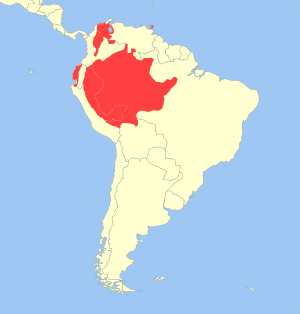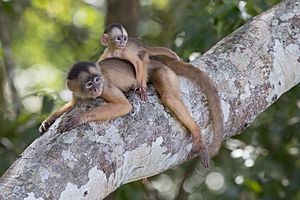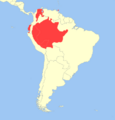White-fronted capuchin facts for kids
Quick facts for kids White-fronted capuchin |
|
|---|---|
 |
|
| Scientific classification | |
| Kingdom: | Animalia |
| Phylum: | Chordata |
| Class: | Mammalia |
| Order: | Primates |
| Suborder: | Haplorhini |
| Infraorder: | Simiiformes |
| Family: | Cebidae |
| Subfamily: | Cebinae |
| Genus: | Cebus |
| Groups included | |
|
|
 |
|
| Geographic range of the various white-fronted capuchin species in South America | |
| Cladistically included but traditionally excluded taxa | |
|
|
White-fronted capuchins are a group of gracile capuchin monkeys. They were once thought to be a single species, Cebus albifrons. These monkeys live in seven countries in South America. You can find them in Bolivia, Brazil, Colombia, Venezuela, Ecuador, Peru, and Trinidad and Tobago.
These monkeys are medium-sized. They have a light brown back and a creamy white belly. Like other capuchin monkeys, they eat many different things. Their diet includes fruits, invertebrates (like insects), other plant parts, and sometimes small animals.
White-fronted capuchins are hunted by raptors (birds of prey) and small cats. The margay is one such cat. Snakes have also been known to attack them. These monkeys live in large groups of 15 to 35 individuals. Females usually have one baby every two years. They use an area of about 1.2 to 1.5 square kilometers for their home. They also have many different sounds they use to communicate. They are one of the few primates known to make and use tools in the wild.
White-fronted capuchins are common and found in many places. However, their numbers might be going down. This is likely due to humans destroying their habitat and hunting them. In 2008, some types were listed as "critically endangered." These include the Ecuadorian white-fronted capuchin and the Trinidad white-fronted capuchin. The varied white-fronted capuchin in Colombia is "endangered." Only about 61 Trinidad white-fronted capuchins were counted in 2008.
Contents
About White-Fronted Capuchins
White-fronted capuchins are known for their light brown fur and creamy white undersides. They are very smart monkeys. They are also quite social, living in large family groups.
What They Look Like
Male white-fronted capuchins usually weigh about 3.4 kg (7.5 lb). Females are a bit smaller, weighing around 2.9 kg (6.4 lb). One male in Colombia was even recorded at 5.5 kg (12.1 lb). Their fur is often maroon-white or yellowish-white. They have short fingers and a thumb that can grasp things. Like other capuchins, they have strong teeth. Their large premolars and square molars help them crack nuts.
Some types of white-fronted capuchins have different looks:
- Humboldt's white-fronted capuchin (Cebus albifrons) can be very light colored. They often have yellowish or reddish fur.
- Spix' white-fronted capuchin (Cebus unicolor) also has light, yellowish fur.
- Río Cesar white-fronted capuchin (Cebus cesarae) is very light. It has a cinnamon or brown cap on its head.
- Santa Marta white-fronted capuchin (Cebus malitiosus) is darker brown. It has yellowish shoulders.
- Varied white-fronted capuchin (Cebus versicolor) can be dark or light. Some types are very reddish, especially on their arms and legs.
- Shock-headed capuchin (Cebus cuscinus) is light brown.
Where They Live
White-fronted capuchins live in many different types of forests. They can be found in dry areas and also in forests that flood. They also live in forests with white sand and rocky areas.
In Colombia, they live from the northern mountains down to the Magdalena River valley. They are also found in the eastern parts of the country. South of the Guayabero and Guaviare Rivers, they live throughout the Amazon. They can live at high altitudes, up to 1,500 to 2,000 meters (4,900 to 6,600 ft) high.
Outside Colombia, they live across eastern Ecuador, Peru, and northern Bolivia. They also live in parts of Brazil and Venezuela. Some isolated groups, like the Ecuadorian white-fronted capuchin, live in special forest areas near the Pacific coast.
Places to See Them
You can often see Humboldt's white-fronted capuchins in El Tuparro National Park in Colombia. The Varied white-fronted capuchin is common along the middle Magdalena River. The Santa Marta white-fronted capuchin is easy to spot in Tayrona National Park.
Their Daily Life
Scientists have studied white-fronted capuchins in many countries. This includes Colombia, Peru, Trinidad, and Ecuador.
Group Life
In some areas of Colombia, white-fronted capuchins live in large groups of about 35 monkeys. In other places, where there might be more competition, groups are smaller, around 8–15 individuals. A group might use a home range of about 1.2 square kilometers (0.46 sq mi).
These monkeys spend their day doing different things. They rest, travel, and spend a lot of time finding food. About 61% of their day is spent eating. They mostly move on all fours (quadrupedal). But they also jump, climb, and sometimes walk on the ground. They can be very active on the ground, especially when looking for food. They often sleep high up in trees, sometimes in palm trees.
What They Eat
White-fronted capuchins are omnivores. This means they eat both plants and animals. Their diet mainly includes fruits and small invertebrates like insects. They also eat small vertebrates and bird eggs. They look for food at all levels of the forest, even on the ground.
During dry seasons, when fruits are scarce, they spend more than half their time on the ground. They search for insects in dry leaves. They are very good at handling objects. They can even hunt frogs and drink water from plants where frogs hide. This frog hunting seems to be something they learn from their group.
Their diet includes many types of plants. Figs are very important to them in some areas. Palms are also a key food source, especially their nuts. They drink water from tree holes or from streams and springs. During very dry times, they might rely on a single water source in their home range.
Reproduction and Family Life
White-fronted capuchins are polygamous. This means one male mates with multiple females. A baby capuchin is usually born after about 160 days. Newborns learn to ride on their mother's back. At first, they hold onto any part of her. Soon, they learn that riding on her shoulders or back is best.
All monkeys in the group are interested in the new baby. They try to get close to it if the mother allows. As the baby grows, it starts to climb on other group members. Even adult males show interest and help protect the little one. Young monkeys love to play with each other and with adults.
Social Behavior
Adult males in a group are usually tolerant of each other. But they can be very aggressive towards males from other groups. The main male, called the alpha male, seems to be in charge. All other monkeys watch him closely. If the alpha male gets scared or pays attention to something, the whole group reacts. The presence of adult males makes the smaller females feel safer. Females might even act more aggressive if a male is nearby.
How They Communicate
White-fronted capuchins use many different sounds to talk to each other.
- Ua: A soft bark, used by all when they sense danger.
- Ya: Used by excited monkeys around the alpha male or when danger is seen.
- Eh-eh: A threat sound, often by adult females, with an open mouth showing teeth.
- Squeaky hinge: A threat sound, often by young monkeys.
- Squeal: Used during fights within the group.
- Whistle: Used by young monkeys during conflict.
- Ahr: A call from a lost monkey, answered by others to guide it back.
- Uh!uh!uh!: Common sound during feeding, showing contentment.
- Uch!uch!: An animal trying to keep up with the group.
- Warble: Young monkeys use this to make contact with an adult.
- Purr: Used for close, peaceful contact.
- Chirriar: Peaceful sound during play among young ones.
One important behavior is breaking branches. All monkeys do this, even babies. The alpha male might break large, dry branches with his hands and feet. This makes a loud sound as the branch falls. The group gets very excited and chatters loudly. They often do this when they are no longer afraid of an observer.
Tool Use
Trinidad white-fronted capuchins have been seen using leaves as cups. They drink water from holes in trees. They change the shape of the leaf to make it work as a cup. They use a new leaf each time. This shows that wild capuchins can make and use tools to find food.
Interactions with Other Animals
White-fronted capuchins often travel with squirrel monkeys. Sometimes, they also travel with tufted capuchins and Venezuelan red howlers. Certain birds, like the double-toothed kite, often follow these monkeys.
Capuchins are very alert to large birds of prey. These birds are a threat to them. Other predators include the tayra (a type of weasel) and the Boa constrictor snake. When they see a ground predator, they might make "ya-ya" sounds and break branches. This is a way to scare off the predator. However, if they see a large bird of prey, they scream once and then hide quietly.
Conservation Status
White-fronted capuchins can adapt to different environments. They are found in many places. But some types are in danger. The Ecuadorian white-fronted capuchin is "critically endangered." The varied white-fronted capuchin and Santa Marta white-fronted capuchin are "endangered." We need more information to know the status of the Río Cesar white-fronted capuchin. The shock-headed capuchin might also be "vulnerable" in Colombia.
It is important to count these monkeys and understand their different types. This will help us protect them better. White-fronted capuchins live in many National Parks. They are probably not hunted too much. They can also survive well in areas near humans.
Images for kids





